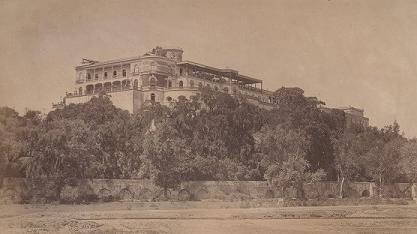| << Chapter < Page | Chapter >> Page > |
Chapultepec castle

Chapultepec (chə-pūl'tə-pĕk') Castle (or, Castillo de Chapultepec ) sits atop Chapultepec Hill in Mexico City. The word Chapultepec is a Náhuatl (the language spoken by the Aztecs) word meaning “grasshopper’s hill” (in Mexico, the common word for “grasshopper” is “chapulín”). The name refers to the hill’s shape, which resembles a grasshopper. The area surrounding the castle is known as the Bosque de Chapultepec (literally “Chapultepec Forest,” but better known as “Chapultepec Park” in English). It is Latin America’s largest urban park (about 2.5 square miles) (Cano).
Chapultepec Hill shows anthropological evidence of the presence of different peoples, including the Toltec and the Aztecs (Zavala). After the Aztecs founded the city of Tenochtitlan (modern-day Mexico City) in 1325, Chapultepec Hill was considered to be a sacred place. Throughout the following years, Aztec rulers ordered several changes to the hill and forest (Cano).
Árbol de montezuma

In 1428, the Aztec king of Texcoco, Netzahualcóyotl, built a retreat and improved the forest’s flora and fauna. Then, in 1465, Montezuma Ilhuicamina ordered that his image be carved in rock at the bottom of the hill and the construction of the Tlaxpana aqueduct (Cano). In 1507, Moctezuma Xocoyotzin had pools created to raise exotic fish and serve as water storage; he ordered that plants and trees from across the empire be planted in the Chapultepec forest. In 1521, Cuauhtémoc Last Aztec ruler defended Chapultepec against the Spaniards. Hernán Cortés then took possession of Chapultepec, giving Captain Julián Jaramillo the northern section. In 1530, a royal decree ruled that the Bosque de Chapultepec belonged to Mexico City (Cano).
During the Spanish Colonial period, Chapultepec Hill was still considered to be one of the area's most beautiful places, suitable for retreats. In 1785, under the rule of New Spain’s Viceroy Bernardo de Gálvez, construction began on a country house at the top of Chapultepec Hill. The architect in charge was Lieutenant Colonel of the Spanish Army and engineer Francisco Bambitelli. When Bambitelli had to depart to Havana, Cuba, the Captain of the infantry and engineer Manuel Agustín Mascaró took over the project (Museo). Despite rapid progress on the project, Viceroy Bernardo de Gálvez died in 1786 before its completion; it was speculated that he was poisoned for actually designing a fortress, rather than a country house, from where he could lead a revolt against the Spanish Crown (Zavala).

Notification Switch
Would you like to follow the 'Hispanic culture for the spanish classroom' conversation and receive update notifications?